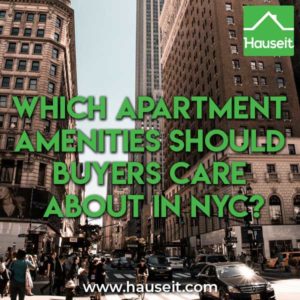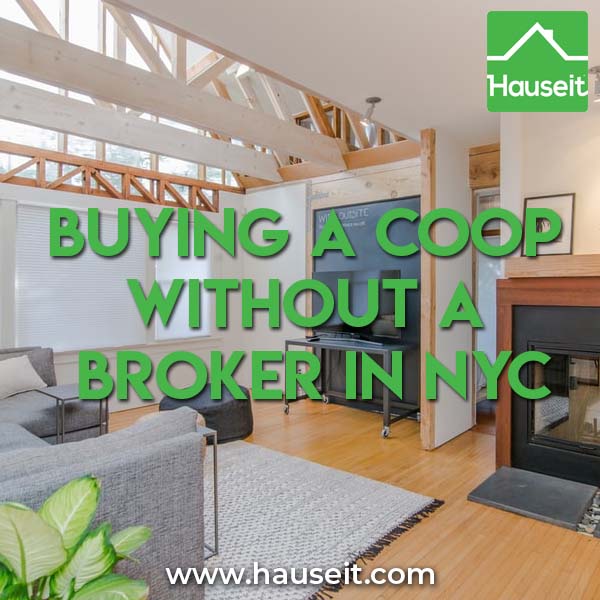While there are many different types of apartment amenities in NYC for buyers to choose from, there are a few key amenities that everyone seems to ask for. In order of importance, these include: in-unit washer dryer, elevator, doorman, outdoor space, live-in super, gym and hardwood floors.
From what we’ve seen from years in the business, having an in-unit washer and dryer and an elevator are by far the two most important amenities to have, and are the amenities that buyers most frequently ask for.
Typical amenities in apartments and buildings in NYC
We’ve listed below all possible building (i.e. accessible by all residents of a building) and in-unit (i.e. an amenity located inside an apartment) amenities allowed by the REBNY RLS when listings are uploaded by real estate agents in New York City.
Keep in mind that not all listing agents will be so diligent in including every possible amenity when they submit their listing, and that most third party websites will have relatively limited search functionality when it comes to amenities.
As a result, you should be more open minded when searching for homes so you don’t run the risk of excluding listings that might actually work for you, but simply don’t have the amenity which you screened for listed.
Typical building amenities in NYC
-
Bicycle Room
-
Children Playroom
-
Courtyard
-
Driveway
-
Garage
-
High Speed Internet
-
Live In Super
-
New Construction
-
Pool
-
Storage
-
Virtual Doorman
-
Brownstone
-
Common Outdoor Space
-
Diplomats OK
-
Elevator
-
Green Building
-
Laundry
-
Lounge
-
Nursery
-
Receiving Room
-
Subway
-
Wheelchair Access
-
Business Center
-
Concierge
-
Doorman
-
Freight Elevator
-
Health Club
-
Laundry Services
-
Maid Service
-
Pied a Terre
-
Roof Deck
-
Valet
-
WiFi
Typical in unit amenities in NYC
-
Balcony
-
Duplex
-
Furnished
-
Hardwood
-
Light
-
Marble Bath
-
NO FEE
-
Original Details
-
Private Deck
-
Room For Rent
-
Sponsor Unit
-
Triplex
-
Wall to Wall Carpeting
-
Dining Room
-
Eat In Kitchen
-
Garden
-
High Ceilings
-
Live Work
-
Microwave
-
One Month Free
-
Outdoor Space
-
Recreational Room
-
Senior Housing
-
Stainless Steel Appliances
-
Vacation Rental
-
Washer
-
Dishwasher
-
Fireplace
-
Granite Kitchen
-
Laundry In Unit
-
Loft
-
Multi Level
-
Open Kitchen
-
Patio
-
Renovated
-
Shares OK
-
Terrace
-
Walk-In Closet
-
Wine Cooler
A Full Service Listing for 1%
Sell your home with a traditional full service listing for just one percent commission.
Just how important is having a washer and dryer in unit?
Having a washing machine and a dryer in the apartment is a must-have for many buyers, especially those with young children or families.
That’s because while it might be easier for a busy, single, working professional to get away with not having a washer dryer in-unit, it becomes extremely inconvenient once you add an infant or young child to the equation.
Just think about it. What will you do with your infant’s dirty diapers? Will you put them in the laundry basket and wait for your next run to the local laundromat to wash them?
In contrast, a single, busy, working professional might easily deal with not having a washer and dryer in the apartment. This type of individual may be so busy with work that he or she doesn’t have time to do their own laundry in the first place. As a result, a washer and dryer might be wasted on this type of buyer who gives all his or her laundry to the local laundromat for a “wash and fold” service.
Elevator or walk-up, does it make a difference?
One of the most common requirements buyers have is for there to be an elevator. This demand actually makes all kind of sense, especially if you’ve ever lived in both and experienced the difference between a walk-up apartment vs an elevator building apartment for yourself.
In fact, many buyers who are okay with a walk-up building will specifically demand that an apartment is no higher than the 3rd floor if the building is a walk-up.
Just think about it, though the building will be better of financially in not having to deal with elevator repairs, the convenience of having an elevator is simply hard to beat.
Any parent who has ever had to carry a stroller up the stairs will know this. Just think about it, if you buy groceries on a regular basis, wouldn’t it be nice not to have to take the stairs and haul up your bags after a long day? Or what about if you’re moving furniture?
Do you really need a doorman?
Many buyers have this idea in their head that they need a doorman building, i.e. a building that has part-time or full-time front desk staff that opens the door and accepts packages on behalf of residents.
While the ability to accept packages is very important these days given the prevalence of e-commerce, and the fact that packages occasionally require a signature for delivery, we believe it’s often a waste of the building’s budget to hire full or even part-time doormen.
For one, the idea of a doorman building is a very antiquated concept that dates from a time many decades ago when NYC was much more dangerous. It might have made sense back then for traditional buildings on the Upper East Side or Upper West Side to have doormen to help protect against any malevolent intruders, and to perhaps lend a hand in the case of harassment nearby the building.
However, the idea of needing a doorman for close-in protection in much of New York City today is preposterous, given that NYC is ranked one of the safest big cities in the world with very low crime rates.
Lastly, keep in mind that most packages won’t require a signature for delivery, and most buildings without doormen will have a vestibule where packages can be safely left.
Oftentimes, deliverymen will buzz a neighbor’s apartment to be let in so they can safely drop the package off in the inner hallway of the building.
How important is outdoor space?
Outdoor space is another common amenity that buyers often demand, whether it be private outdoor space such as a balcony or terrace, or public outdoor space such as a furnished building roof deck.
Keep in mind that having private outdoor space is relatively rare, especially if you’re looking for anything larger than a small balcony.
Furthermore, large terraces have a value of their own, even if it’s not considered indoor square footage. Even though there’s no exact valuation metric for private outdoor space, a common rule of thumb is to value private outdoor space like a private terrace at half the valuation of indoor space.
While we generally think of having private outdoor space as an overpriced luxury, it can be quite useful if for example you are a smoker and need to pop outside for the occasional smoke (presuming that your building’s smoking policy allows smoking at all per the new NYC smoking laws).
However, having public outdoor space like a common roof deck is much more common, and we think just as nice without having to really pay up for the square footage. You can just as easily throw a party on your building’s rooftop as in a private terrace or backyard.
Does the super really need to live in the building?
Occasionally, we’ll come across a buyer who really wants to have a “live-in super” in the building, perhaps because they want a handyman that they can easily call upon in case something needs to be fixed.
This essentially means the building’s superintendent lives in one of the units in the building, sometimes for free in exchange for janitorial and other services.
Whether this is ultimately beneficial for the building’s finances depends on how much the super’s salary would otherwise be vs the current carrying costs of the super’s apartment.
If the super’s salary would be quite high vs the monthly common charges and property taxes attributable to the super’s apartment, then it may make a ton of sense to have a live-in super.
Remember that for most re-sale deals, the actual cost of the super’s apartment was paid for long ago by the original purchasers of the apartment.
Does having a gym in the building matter?
Though some buyers will screen for high amenity, luxury buildings with amenities as varied as indoor pools, cinemas, spas, saunas and health clubs, it’s debatable whether having such amenities are worth the additional cost involved.
For example, just because a building has a gym in the building does not mean you will use it, or that it will be up to par compared to health clubs like Equinox. In fact, it’ll be very unlikely that your building’s gym will be anything close to your local Equinox, which you might pay for anyway just to “get out of the house.”
Why do buyers like hardwood floors so much?
Some buyers will screen for listings that advertise hardwood floors, and in fact hardwood floors is one of the most commonly advertised amenities on listings in NYC.
So why are hardwood floors so popular? Well, we think it’s because they’re the best alternative compared to what else is out there. Think about it, if you don’t have hardwood floors, what do you have?
There’s tile, parquet, carpet over concrete and so forth. However, none of these options are typically appealing to today’s home buyer. For whatever reason, buyers today prefer a clean, elegant hardwood floor vs anything that reminds them of their grandmother’s home.
Fewer amenities means less expenditure and liability
Buying an apartment in a no frills building with few or no amenities is great if you’re looking to keep costs low, and want to own an apartment with low monthly common charges or maintenance fees.
Often times owners of a no or low amenity building are all of the same mindset, and no frills buildings are often so frugal that they are self-managed condos and co-ops.
Think about it this way, every amenity that the building doesn’t have is one less cost or liability that the building collectively has to worry about.
For example, if there isn’t an elevator, then no one has to worry about spending six figures to replace the elevator.






